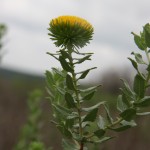Curlycup Gumweed
Grindelia squarrosa (Pursh) Dunal
Asteraceae (Sunflower Family)
Description
This forb is a common invader of overgrazed pastures. It is one of ten species of Grindelia in Texas and itself has three varieties, mainly with leaf differences. A member of the Sunflower (Asteraceae) family, Curlycup Gumweed is a weedy, warm-season annual, or short-lived perennial. It is often observed with stems emerging from the prior year’s rootstock. The SW Field Guide excerpt in SEINet says “good indicators of this species are the sticky, resinous herbage; yellow flower heads with phyllaries that have distinctive spreading or recurved tips; and oblong, saw-toothed leaves.” The plant may be branched or unbranched, and it can vary from 8 to 35 inches or 20 to 90 cm tall. Its stems are stiff and sticky, usually whitish but sometimes reddish or grayish. Curlycup Gumweed starts growth in late spring, begins to flower in July or August, and dries up in late summer. The simple, thick, alternate leaves are quite variable. They are usually hairless, shiny green, and heavily toothed along the margins. They tend to clasp the stem. Their shape is oblong to ovate up to 5 cm long but shorter towards the flower heads. The leaf surfaces bear stalked glands. The terminal flowers, sometimes numerous, are yellow and very sticky below the disk flowers. Ray flowers may be absent or 25 to 40. Disk flowers are a darker yellow. The about 2.5 cm flowers are mostly in the upper branches. The flower heads’ bracts are 5 to 6 overlapping series forming a cup with the lower outer bracts curling downward. They are very glutinous. The plant has been suspected of accumulating selenium. It has poor grazing value for wildlife. When young, it has some value for livestock. However, it is not palatable. While highly attractive to bees, the resulting honey is of poor quality.Habitat
This plant grows mainly in waste areas and disturbed areas on sands, clay, and sub-alkaline soils as a weedy perennial. It has adapted to disturbed sites receiving less than 20” of rain. Howard Irwin in Roadside Plants of Texas states “Gumweed often takes possession of run-down pastures, especially during long periods of drought.”Images
Plant Characteristics
Flower Color: Yellow
Seed Type: Achene
Duration: Annual, Biennial, Perennial
Stem Texture: Hairless/Smooth
Growth Habit: Forbs/Broadleaf
Leaf Shape
 : Simple with Pinnate or Parallel Venation
: Simple with Pinnate or Parallel Venation
Season: Warm
Distribution
 : 01 - Pineywoods, 03 - Post Oak Savannah, 04 - Blackland Prairies, 05 - Cross Timbers and Prairies, 07 - Edwards Plateau, 08 - Rolling Plains, 09 - High Plains, 10 - Trans-Pecos
: 01 - Pineywoods, 03 - Post Oak Savannah, 04 - Blackland Prairies, 05 - Cross Timbers and Prairies, 07 - Edwards Plateau, 08 - Rolling Plains, 09 - High Plains, 10 - Trans-Pecos
Distributions
Distribution refers to the ecological region in Texas that a plant has been found. You can also view a clickable map.
Book: Brush and Weeds of Texas Rangelands (B-6208)
Collection: Brush and Weeds







